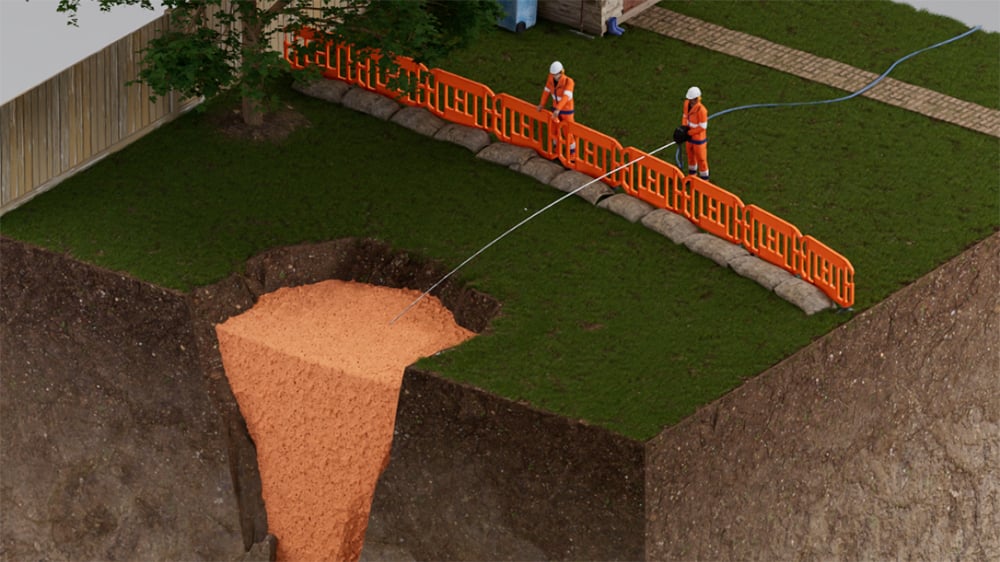Visible indicators
Cracks on internal and external walls
Cracks are the most common sign of subsidence. Here are the key types to watch for:

Stair-step cracks
Follows the mortar lines in brickwork, stepping up or down the wall.

Settlement cracks
A general term for cracks caused by the home's foundation settling downwards.

Hairline cracks
Very fine, thin cracks that can appear in plaster, often the earliest sign.

Vertical cracks
Runs straight up and down, often wider at the top or bottom.

Diagonal cracks
Spreads out from corners of windows or doors, usually at a 45-degree angle.

Horizontal cracks
Runs sideways along walls, potentially indicating significant structural stress.
Floors, windows, doors, and extensions
While cracks are the most famous sign of subsidence, the earliest clues can be more subtle. When the ground beneath your home moves, it can gently twist the entire frame of the building. This distortion can show up in ways you might not immediately connect to a ground problem, from sloping floors to doors and windows that suddenly begin to stick.

Uneven and sinking floors
You may notice a sinking or sloping feeling when walking across a room. Furniture might lean to one side, or you may see a visible gap appearing between your floor and the skirting boards. This is often a clear indication that the ground beneath your floor is no longer providing adequate support.

Misaligned and hard to open doors and windows
When your home's foundation shifts, it distorts the frames of doors and windows. This causes them to stick, jam, or no longer close properly. You might also notice that latches no longer line up, or gaps have appeared around the frames, letting in drafts.

Sinking bay windows or home extensions
Bay windows and extensions are often built on shallower foundations than the main house, making them more vulnerable to movement. You may notice cracks appearing where the extension joins the main property, or the entire structure may seem to be pulling away from the house.

Wall coating damage
Subsidence movement often causes cosmetic damage indoors. Look for crinkling or tearing in wallpaper with no signs of damp, or fine cracks appearing through plaster or render. These signs often correspond with larger structural cracks hidden underneath the wall's surface.

Appearance of ground voids and sinkholes
In some cases, you might notice dips or holes appearing in your garden or driveway near your home’s foundation. This can be a sign of soil being washed away or compacting, leaving an unsupported void beneath the ground that can lead to sudden settlement.
Most common causes of subsidence in the UK

Clay shrinkage
Clay soil, common in London and the South East, shrinks as it dries during long, hot summers, causing the ground to shift.
Leaking drains and water mains
Water washing away or softening the soil beneath your foundations is one of the leading causes of subsidence.
Tree roots
Large trees and shrubs growing too close to your home can draw vast amounts of moisture from the soil, causing it to shrink.
Poor ground compaction
If the ground was not properly compacted when your home was built, it can consolidate over time, causing settlement.
Worried about your home?
If you've noticed any of these signs, don't wait for the problem to get worse. Contact our expert team today for a professional assessment and a clear plan to secure your home.


Frequently asked questions about subsidence
When you see potential signs of subsidence, it’s natural to have a lot of questions and concerns. Below, we’ve answered some of the most common queries we hear from homeowners to give you clear, straightforward information.
These terms describe different types of ground movement.
Settlement is the normal, even, downward movement a new building experiences as the ground compacts under its weight.
Subsidence is the uneven sinking of the ground beneath an existing property, caused by problems with the soil.
Heave is the opposite of subsidence—it's the upward movement of the ground, usually when clay soil swells after a long dry spell or the removal of a large tree.
While the classic signs include diagonal cracks, sticking doors, and rippling wallpaper, the only way to be certain is with a professional site investigation.
An expert can assess the signs and determine the specific cause of the movement, which is the first step toward the right solution.